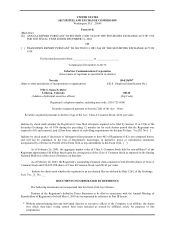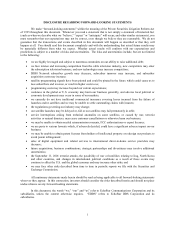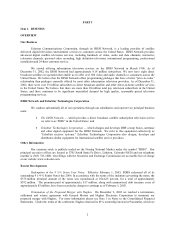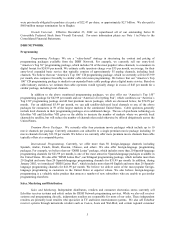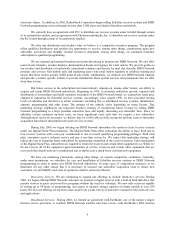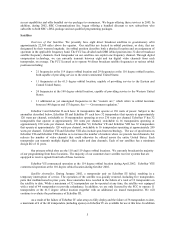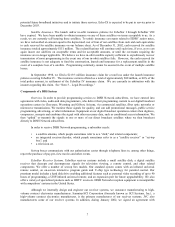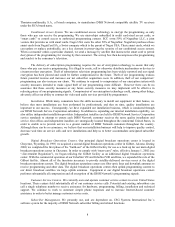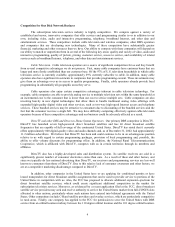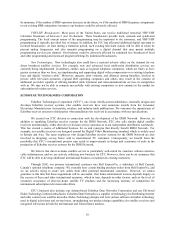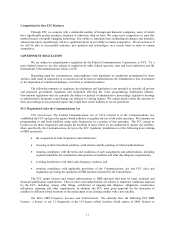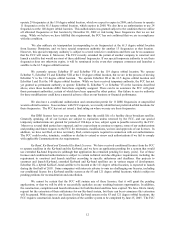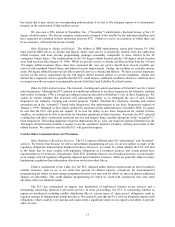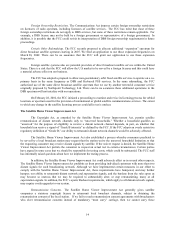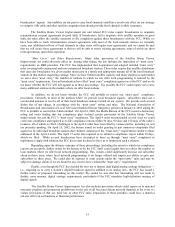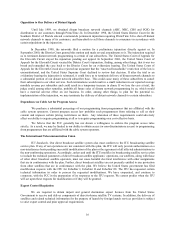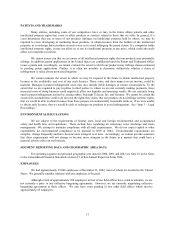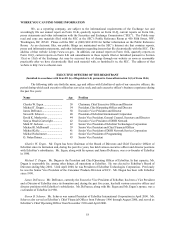Dish Network 2002 Annual Report Download - page 11
Download and view the complete annual report
Please find page 11 of the 2002 Dish Network annual report below. You can navigate through the pages in the report by either clicking on the pages listed below, or by using the keyword search tool below to find specific information within the annual report.9
Competition for Our Dish Network Business
The subscription television service industry is highly competitive. We compete against a variety of
established and newer, innovative companies that offer services and programming similar to or in addition to our
own, including video, audio and interactive programming, telephony, broadband Internet, and other data and
entertainment services. These competitors include cable television and wireless companies, other DBS operators
and companies that are developing new technologies. Many of these competitors have substantially greater
financial, marketing and other resources than we have. Our ability to compete with these companies will depend on
our ability to match or outperform them in several of the following key areas: quality and variety of video, audio and
interactive programming, quality of picture, pricing, customer service, access to service, and availability of related
services such as broadband Internet, telephony, and other data and entertainment services.
Cable Television. Cable television operators are a source of significant competition for us and they benefit
from several competitive advantages we do not possess. First, many cable companies have customer bases that are
larger and more firmly established than our customer base. Of the 97% of U.S. television households in which cable
television service is currently available, approximately 69% currently subscribe to cable. In addition, many cable
operators also have significant investments in companies that provide programming content. These investments may
give them an advantage over us in access to quality programming. Finally, cable operators already provide local
programming in substantially all geographic areas they serve.
Cable operators also enjoy certain competitive advantages inherent in cable television technology. For
example, cable companies are able to provide analog service to multiple television sets within the same household at
an incremental cost to the consumer that is lower than our cost to service multiple sets. Cable companies are also
investing heavily in new digital technologies that allow them to bundle traditional analog video offerings with
expanded high-quality digital video and other services, such as two-way high-speed Internet access and telephone
services. These bundled services may be attractive to consumers due to discounting of the bundled services and the
fact that the consumer receives a single bill. We may have difficulty competing effectively against cable television
operators because of these competitive advantages and our business could be adversely affected as a result.
DirecTV and other DBS and Direct-to-Home System Operators. Our primary DBS competitor is DirecTV.
DirecTV has launched seven high-powered direct broadcast satellites and has 46 direct broadcast satellite
frequencies that are capable of full coverage of the continental United States. DirecTV has stated that it currently
offers approximately 800 digital-quality video and audio channels and, as of December 31, 2002, had approximately
11.2 million subscribers. We believe that DirecTV has been and could continue to be in an advantageous position
relative to us with regard to certain programming packages, provision of local programming and, possibly, the
ability to offer volume discounts for programming offers. In addition, the National Rural Telecommunications
Cooperative, which is affiliated with DirecTV, competes with us in certain territories through its members and
affiliates.
DirecTV also has a highly-developed sales and distribution system. Its satellite receivers are sold in a
significantly greater number of consumer electronics stores than ours. As a result of these and other factors, and
since we typically do less national advertising than DirecTV, our receivers and programming services are less well
known to consumers than those of DirecTV. Due to this relative lack of consumer awareness and other factors, we
are at a competitive marketing disadvantage compared to DirecTV.
In addition, other companies in the United States have or are applying for conditional permits or have
leased transponders for direct broadcast satellite assignments that can be used to provide service to portions of the
United States in competition with us. Also, the FCC has proposed to allocate additional expansion spectrum for
direct broadcast satellite services, which could create significant additional competition in the market for
subscription television services. Moreover, as evidenced by a recent application filed at the FCC, direct broadcast
satellite service providers may seek and receive authority to service the United States market from full-CONUS slots
allocated to other nations, particularly where such nations have entered into bilateral agreements with the United
States. Other competitors include C-Band satellite providers and overlay services, which are particularly competitive
in rural areas. Finally, one company has applied to the FCC for permission to serve the United States with DBS
service from an orbital location midway between the 110 degree orbital location and the 101 degree orbital location.

